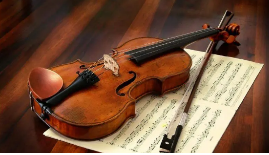What is the essence of Western music? Why the rapid rise of Western music in Western art?
4 min read
Humans are born with the ability to perceive the “sounds” in the implicit world through the “sounds” in the explicit world. This ability is called “inner hearing” in modern professional music training.”Inner hearing” is actually the perception ability of “the innermost level of consciousness”, which is a kind of “inner perception”.Everyone has “inner hearing”, but few people have “inner hearing” strong, “inner hearing” after professional training, basically can become musicians.
So, how to make the “inner hearing” is not strong, or even can not feel the “inner hearing”, but also from music to strengthen the “inner hearing”?
This is the inner motivation for the rapid rise of “Western music” in the Renaissance!
“Western music” has developed a whole set of methods for organizing abstract “sounds”, so that people with “inner hearing” can also feel the organized “concrete” connotation from “abstract” sounds.
In the time of Pythagoras, the “sound” of western music refers to the precise distinction and definition of the composition of “sound” with “number” after in-depth understanding of “sound”.
That is to say, the “sound” after being accurately distinguished and defined is the “sound” of Western music. The twelve equal temperament is the product of this precisely differentiated sound.
After the precise distinction of “sound”, there are the basic elements of “sound”, and then use the basic elements of “sound” to organize accordingly, so forming a series of “sound”, is “monotonous” music. Chinese folk music is “monotonous” music.
If this “monotone” music is regarded as a “horizontal” structure, then some new “sounds” are added to the “vertical” of some “acoustic” elements for “decoration”. Then these “decorative” “acoustic” elements will form “harmony”.
Among these newly increased “harmonies”, a new “monotony” is also formed in the “horizontal” relation, thus forming “polyphony” with the original “monotony”. Western music is basically polyphonic.
For ordinary listeners, the greatest advantage of “polyphony music” lies in that only by “listening in” can people feel the very concrete “sound structure” similar to “architecture”, and through this “sound structure” can they feel the deeper connotation that the composer wants to express in the music.
This is the training of feeling concreteness through abstraction.
Therefore, the “sound” of western music is essentially “sound”.
Many great Western composers create “music” on the basis of feeling “sound”, that is to say, great composers in the creation of music, do not need “sound”, for example, Beethoven, Smetana are deaf, can not hear the sound.
Beethoven wrote easy works like “To Alice” before he lost his hearing, but after he lost his hearing, he created all his great works. The Fate that we are familiar with is Beethoven’s work after he lost his hearing.
And here’s a little bit more about the role of the performer in performance.
People who do not know how to play music generally understand “music score” as “program”, and think that as long as playing according to “music score”, it will be the same as the input of “program”, and the final output result from the instrument will be the same. In the process, the performer just plays the role of skillfully and accurately input music.
Therefore, some people think that the player can be replaced by computer input, because the computer input is infallible.
This is a serious misunderstanding!
Real performers are people with strong “inner hearing”. They can feel the “sounds” behind the “sound structure” of the musical works. These “sounds” have a sense of picture, color, temperature and space in their feelings.
In addition to the direct perception of the music score, the performer also has the perception of the composer’s inner thoughts during the creation of the work, because the music on the music score is not equal to the whole content created by the composer. So far, human beings have not invented a way of expression that can present the whole content of the music in the composer’s consciousness, and only part of the music is presented from the music score. Then, The complete part of the work requires the performer to perceive, understand…
Therefore, the real value of a performer lies in the performance of these connotations he feels from his inner hearing.
Therefore, for those who truly “understand” the music, the same piece of music is different in the performance of different players, and the same player in different periods, the performance is also different. This is where Western music is at its most interesting and subtle, and where it trains the listener’s inner hearing.
For a strategic, innovative thinker, music appreciation is a very important training.






